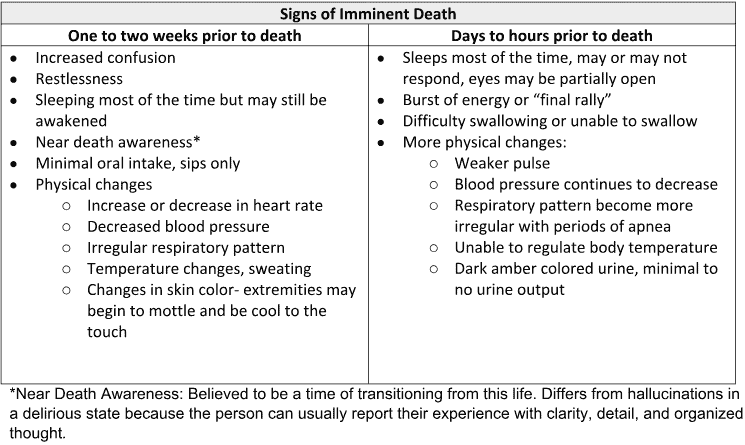The Transitioning Phase of The Dying Process
Published on August 18, 2023
Updated on November 7, 2024
Published on August 18, 2023
Updated on November 7, 2024

Table of Contents
Losing a loved one is an incredibly challenging and emotional experience. Knowing what signs to look for can be helpful if you find yourself in the presence of someone in the transitioning phase of the dying process. Although every individual’s experience may vary, some common observations may indicate someone is in the transitioning phase. Here’s a guide to help you recognize these signs and provide support during this grim time.
When someone is in the transitioning phase of the dying process, they may exhibit certain physical changes. While it’s important to remember that these signs can vary from person to person, here are some common observations you may witness (the more below that is observable to you, the greater the possibility your loved one is transitioning):
In addition to physical changes, there may also be behavioral and psychological signs that indicate someone is in the transitioning phase. Here are some observations you may notice (as mentioned above with the physical changes, the more you see of the below, the greater the possibility your loved one is transitioning):
Recognizing these signs can help you understand the person’s condition and provide the support they need during this delicate phase. Here are some ways you can help:
Remember, each person’s experience is unique, and the signs mentioned may not be present in every case. It’s essential to seek guidance from healthcare professionals or hospice care providers who can offer further insight and support tailored to the individual’s needs.
Recognizing the signs of the transitioning phase of the dying process can help provide the necessary support and comfort to your loved one during this delicate time. Physical changes such as decreased energy, appetite, breathing patterns, skin changes, and alterations in consciousness may indicate the transitioning phase. Additionally, behavioral and psychological changes like withdrawal, communication difficulties, restlessness, visions or hallucinations, and emotional vulnerability may also be observed. Providing support by being present, creating a calm environment, using a gentle touch, listening, and respecting their wishes can offer comfort and reassurance to the individual. It’s important to remember that each person’s experience is unique, and seeking guidance from your hospice care provider is crucial for tailored support based on individual needs.
Preparing the patient, family, and caregivers for a “Good Death”
Velocity of Changes in Condition as an Indicator of Approaching Death (often helpful to answer how soon? or when?)
The Dying Process and the End of Life
How to Recognize That a Loved One Is Dying
End-of-Life Signs — Beth Cavenaugh
Kubler-Ross Stages of Dying and Subsequent Models of Grief
Transitioning in Hospice: End-of-Life Process Explained – Fairways Cottage Retirement Living
What Are the Three Stages of Dying?
CaringInfo – Caregiver support and much more!
Surviving Caregiving with Dignity, Love, and Kindness
Caregivers.com | Simplifying the Search for In-Home Care
As an Amazon Associate, I earn from qualifying purchases. The amount generated from these “qualifying purchases” helps to maintain this site.
Take Back Your Life: A Caregiver’s Guide to Finding Freedom in the Midst of Overwhelm
The Conscious Caregiver: A Mindful Approach to Caring for Your Loved One Without Losing Yourself
Everything Happens for a Reason: And Other Lies I’ve Loved
Final Gifts: Understanding the Special Awareness, Needs, and Communications of the Dying
Providing Comfort During the Last Days of Life with Barbara Karnes RN (YouTube Video)
Preparing the patient, family, and caregivers for a “Good Death.”
Velocity of Changes in Condition as an Indicator of Approaching Death (often helpful to answer how soon? or when?)
The Dying Process and the End of Life
As an Amazon Associate, I earn from qualifying purchases. The amount generated from these “qualifying purchases” helps to maintain this site.
Gone from My Sight: The Dying Experience
The Eleventh Hour: A Caring Guideline for the Hours to Minutes Before Death